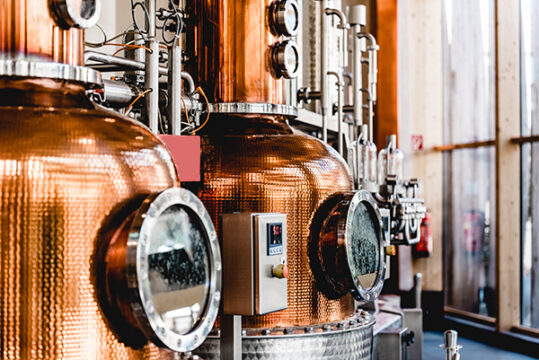
Among all the dire news surrounding the COVID-19 crisis, there’s one story that’s lightened a lot of people’s moods: distillers of alcoholic beverages (including several in the Chicago area) switching over some of their production to make desperately needed hand sanitizer.
We love this story because:
- Supplies of hand sanitizer have been running low at health care facilities for weeks, and the demand is only getting higher.
- Effective hand sanitizer should be 80% ethanol alcohol (or 75% isopropyl alcohol) by volume, so it makes sense for distilleries to step up since their operations can be converted to create ethanol.
- We’re positively inclined toward those companies that make our favorite beverages anyway.
But there’s one more reason these efforts merit our special attention: Hand sanitizer is a completely different hazardous material than the alcoholic beverages these distilleries usually ship. We want to make sure they know everything they need to know to help make these shipments safe and compliant.
“There are a lot of variables” for compliant hand sanitizer shipping
Alcoholic beverages are Class 3 Flammable Liquids, UN 3065. Hand sanitizers, with different types and concentration of alcohol, are classified differently. They’re still Class 3 Flammable Liquids, but they are typically classified as either Ethanol Solutions, UN 1170 (if Ethanol is the only alcohol used) or Alcohols, N.O.S., UN 1987 (if multiple alcohols are used).
According to Labelmaster Manager of Regulatory Affairs and Corporate Responsibility Brian Beetz, “There are a lot of variables. From a regulatory standpoint it depends on what exactly the distilleries are doing.”
Here are some of the variables in play that impact how hand sanitizer can be compliantly shipped:
- What are you actually making? “Some distilleries might be converting to make ethanol, then shipping the ethanol to someone else who’s making the hand sanitizer,” says Beetz. “Others are acquiring all of the other components and trying to make the hand sanitizer itself. The classification of the final product and volume per container must be evaluated to determine packaging and shipping requirements.”
- What are you adding? Some hand sanitizers contain isopropyl alcohol (UN 1219) instead of ethanol (UN 1170); some contain both, and can also include small amounts of hydrogen peroxide solution in addition to glycerol and sterile water..
- How much are you shipping, and in what size containers? The current limit for Limited Quantity shipments for flammable liquids assigned to Packing Group III is 5 liters (1.3 gal.) per inner container, and if it’s Packing Group II the per container limit is reduced to 1 liter (0.3 gal.) (although Beetz says shippers are lobbying PHMSA to temporarily expand that limit to as much as five gallons per single container to help facilitate shipping during the COVID-19 situation). Beetz says, “Limited Quantity shipments require no shipping papers, have less restrictive training requirements, and incur no hazmat surcharges—but packaging your product in smaller containers is more costly than shipping it in larger drums.”
UPDATE: On Friday April 2nd, PHMSA provided emergent guidance on domestic ground shipment of non-bulk quantities of alcohol based hand sanitizers. The guidance offers some relaxation of otherwise typical requirements and specifies certain measures as an alternative. See the full guidance here.
FDA’s recommendations for temporary compounding of hand sanitizer
Before you ship hand sanitizer, of course, it has to be made properly. In response to the pandemic and the resulting shortage of hand sanitizer, the FDA has issued a “Policy for Temporary Compounding of Certain Alcohol-Based Hand Sanitizer Products During the Public Health Emergency.” (You can download it here.) It contains these nonbinding recommendations for compounding:
- The hand sanitizer is compounded using only the following United States Pharmacopoeia (USP) grade ingredients in the preparation of the product (percentage in final product formulation) consistent with World Health Organization (WHO) recommendations:
- Alcohol (ethanol) (80%, volume/volume (v/v)) in an aqueous solution denatured according to Alcohol and Tobacco Tax and Trade Bureau regulations in 27 CFR part 20; or Isopropyl Alcohol (75%, v/v) in an aqueous solution.
- Glycerol (1.45% v/v).
- Hydrogen peroxide (0.125% v/v).
- Sterile distilled water or boiled cold water.
- The compounder does not add other active or inactive ingredients. Different or additional ingredients may impact the quality and potency of the product.
- The compounder pays particular attention to ensure the ethanol or isopropyl alcohol active ingredient is correct and the correct amount of the active ingredient is used.
- The hand sanitizer is prepared under conditions routinely used by the compounder to compound similar nonsterile drugs.
- The hand sanitizer is labeled consistent with the attached labeling in Appendix A (Labeling for Ethyl Alcohol Formulation Consumer Use), Appendix B (Labeling for Isopropyl Alcohol Formulation Consumer Use), Appendix C (Labeling for Ethyl Alcohol Formulation Health Care Personnel Handrub Use), or Appendix D (Labeling for Isopropyl Alcohol Formulation Health Care Personnel Handrub Use).
The download contains important details and helpful labeling recommendations, too. Please consult this document before converting your operations to make hand sanitizer.
For more information or help answering your dangerous goods shipping questions, please call the Labelmaster Regulatory Hotline at 1.800.621.5808, or email us your questions for a written response.
Make sure your shipments are safe and in complete compliance with a full line of solutions from Labelmaster—a full-service provider of goods and services for hazardous materials and Dangerous Goods professionals, shippers, transport operators and EH&S providers.



The FDA also has guidance for other manufacturing facilities who want to make hand sanitizer. If you are not covered by the Compounding Guidance, you might fall under this one. It allows companies to register with the FDA if they are not already registered. You can download that one here https://www.fda.gov/news-events/press-announcements/coronavirus-covid-19-update-fda-provides-guidance-production-alcohol-based-hand-sanitizer-help-boost
Thanks for sharing that, Denese!
Excellent